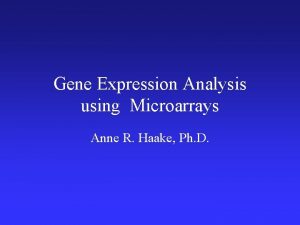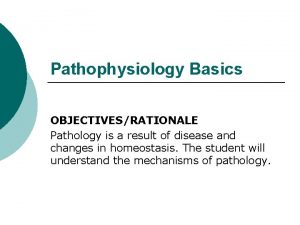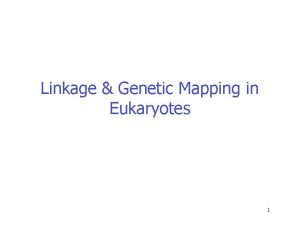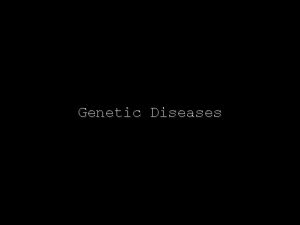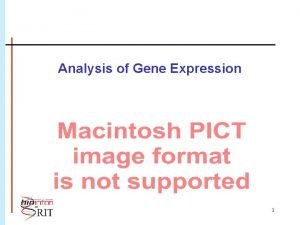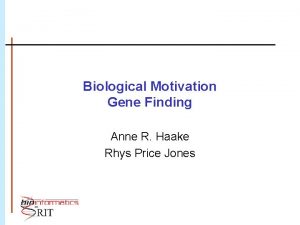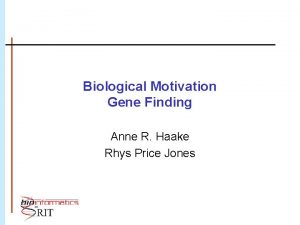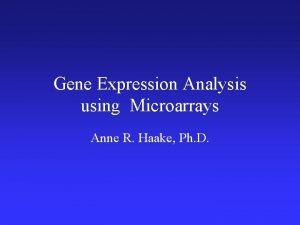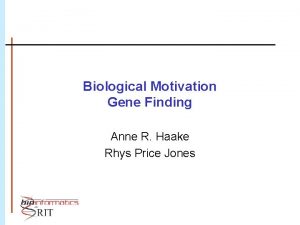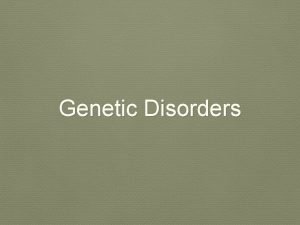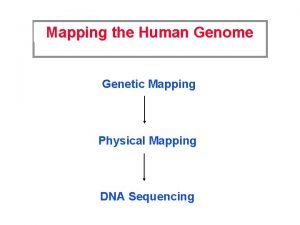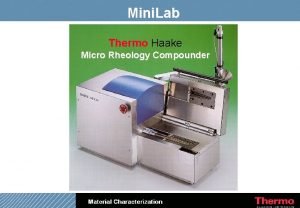Mapping of Simple Complex Genetic Diseases Anne Haake




























- Slides: 28

Mapping of Simple & Complex Genetic Diseases Anne Haake Rhys Price Jones

Simple Diseases • Follow Mendelian inheritance patterns – e. g. autosomal dominant, x-linked recessive • Generally rare • Caused by changes in one gene • Examples: Cystic Fibrosis, Duchenne Muscular Dystrophy

Complex Diseases • aka Common Diseases • Tend to cluster in families but do not follow Mendelian inheritance patterns • Result from action of multiple genes • Alleles of these genes are “susceptibility factors” • Most factors are neither necessary or sufficient for disease • Complex interaction between environment and these susceptibility alleles contributes to disease

Complex Diseases • Examples: diabetes, asthma, cardiovascular disease, many cancers, high blood pressure, Alzheimer’s disease • Many more. .

How do we study these? • Simple diseases: – Usually a complete correlation between genotype and phenotype – “easy” to analyze • A nice overview of strategies by Dennis Drayna at NHGRI • http: //www. nhgri. nih. gov/Pages/Hyperion/CO URSE 2000/Pdf/Drayna. pdf

Positional Cloning Approach • Isolate a disease gene based on its chromosomal position • No prior knowledge of structure, function, or pathological mechanism

Need some markers • DNA polymorphisms “many forms” • Variation in population allows us to use them as informative markers • Identified by common lab techniques such as PCR • Examples: – RFLP-restriction length polymorphisms – Microsatellites- tandem repeats, e. g (CA)n – SNPs-single nucleotide polymorphisms

Recombination Frequency • RF (genetic distance), also called q (theta) between 2 loci is related to how far apart they are on the chromosome (physical distance) • So. . can estimate physical distances by measuring q. • 1% RF roughly equivalent to 1 c. M (1 Mb DNA) http: //www. abdn. ac. uk/~gen 155/lectures/gn 380 1 b. htm#ls

Strategy • Look for co-inheritance of disease and some marker; known as linkage • If a marker (polymorphism) is close to a disease gene then there is a low chance of meiotic recombination between them • Family studies are required; study of individuals in generations allows us to figure out pattern of inheritance of disease relative to markers • Generate LOD Scores http: //www. ndsu. nodak. edu/instruct/mcclean/plsc 431/lin kage/linkage 6. htm

An Example: Darier's Disease Synonyms: Mc. Kusick #12420 Darier-White Disease Keratosis follicularis Genetics: autosomal dominant high penetrance 1: 100, 000 Denmark 1: 36, 000 northeast England

Key Recombinants

Genes Mapped to 12 q 23 -24. 1 IGFInsulin-like Growth Factor NFYB Nuclear Factor Binding to Y PAH Phenylalanine Hydroxlyase TSC 3 Tuberous Sclerosis ACADS acyl-coenzyme A dehydrogenase ATP 2 A 2 ATPase Ca++ transporting SCA 2 Spinal Cerebellar Ataxia MYL 2 Myosin light polypeptide PMCH pro-melanin-concentration PLA 2 A Phospholipase 2 A IFNG Interferon gamma PPP 1 CC Protein phosphatase 1 ALDH 2 Aldehyde dehydrogenase NOS 1 Nitric Oxide Synthase TRA 1 Tumor Rejection Antigen ZNF 26 Zinc Finger Protein TCF 1 Transcription Factor 1 UBC Ubiquitin C SPSMA Scapuloperoneal spinal muscular atrophy

Burden of Proof • Mendelian traits (1) Mapping the gene to a small genetic interval (2) Study of candidate genes (3) identification of sequence variants (often coding, but not always) in affected individuals • More difficult for complex traits

Quantitative Trait Loci (QTL) • Complex traits are also known as QTLs • Term used most in agricultural, horticultural genetics • Why quantitative? • Consider Mendelian traits – Cross short pea plant vs. tall pea plant – F 2 generation: you know the genotype of the short plants and you can generalize the genotype of the tall & can predict phenotype from genotype – Phenotypes are called discontinuous traits

• Complex traits don’t fall into discrete classes • Consider ear length in corn – Cross short ears with long ears – F 1 generation: intermediate ears – F 2: ranges from short to tall with intermediate lengths in a normal distribution • Called continuous traits • Often given a quantitative value • Loci controlling these traits are QTL

Complex Diseases • Difficult to study • Conflicting theories of the genetics underlying these diseases • 2 major theories: very controversial! • Common Disease/Common Variant (CD/CV) • Common Disease/Rare Allele (CD/RA)

• CD/CV – Alleles that existed prior to the global dispersal of humans or those subject to positive selection represent a significant proportion of the susceptibility alleles for common disease • CD/RA – Most mutations underlying common disease have occurred after the divergence of populations – Expect heterogeneity in genes in common diseases

CD/CV • Susceptibility alleles confer moderate risk and occur at relatively high rates in the population (>= 1%). • Suggests that association studies in large cohort populations (e. g. unrelated individuals sharing the common disease) will be fruitful • SNPs have facilitated this type of study – easy to measure, stable in population

SNPs • Single Nucleotide Polymorphisms (SNPs) “snips” • SNP Facts: – – – – Humans share about 99. 9% sequence identity The other 0. 1% (about 3 million bases) are mostly SNPs occur about every 1000 bases There are “hot-spots” Most SNPs have only 2 alleles Most SNPs not in coding regions (99% not in genes) SNPs can cause silent, harmless, harmful, or latent changes • Current estimates only about 2000 of the 2. 3 million change an amino acid – Haplotype: a set of SNPs along a chromosome http: //www. genome. gov/10001665

SNPs • Where does SNP data come from? • Lots of sources: – – – Parallel sequencing on a genome-wide scale EST data mining BAC clone sequencing Sequencing within suspected disease genes Sequencing of individual chromosomes • Questions for validation – Are they sequencing errors? Is a suspected SNP simply a splice variant? Duplicated regions?

Association Studies • SNPs usually serve as biological markers rather than underlying cause of disease • SNP is located near a gene associated with a disease • Allelic association aka linkage disequilibrium • Compare genome wide SNP profiles from individuals with the disease to those without the disease. • Difference identifies a putative disease profile that may eventually be used in diagnosis

Haplotype Mapping • Definition of a complete Hap. Map one of the goals of the SNP Consortium • Questions remain in the community about the degree of linkage disequilibrium in the human population • Estimates vary from 3 kb-400 kb • Not very useful for disease mapping at either end

Burden of Proof • Complex Diseases-what are the steps to gene discovery? (1) Linkage or Association -challenges in testing numerous genetic markers for linkage and correlating inheritance patterns -minimal intervals of QTLs are usually no less than 10 -30 c. M (typically 100 -300 genes in that interval) -makes candidate gene studies difficult

Burden of Proof for Complex Diseases • (2) Fine-mapping – Genetic crosses, family-based studies of linkage disequilibrium using dense markers – Are SNPs the optimal markers? • (3) Sequence analysis to identify candidate variants • (4) Functional tests such as replacement of variant to swap phenotypes • (5) Additional evidence at cellular and tissue levels

Model Organisms • One of most promising approaches is to extend the human mapping studies to animal models • Take advantage of highly inbred strains • Take advantage of genome synteny to relate mouse results back to human genes.

Successful Use of Genome-Wide Screens • Alzheimer’s disease – Apo. E gene has 2 SNPs – 3 alleles Apo. E 2, Apo. E 3, Apo. E 4 – Association of the Apo. E 4 allele with Alzheimer’s disease & APOE 4 protein in brain lesions • Mouse: mutations in tubby gene – Cause obesity, retinal degeneration, hearing loss – More evidence of multi-gene interactions • Modifier gene (moth 1) protects tubby mice from hearing loss • Mtap 1 a c. DNA rescues hearing loss

High-throughput SNP analysis • Genotyping via oligonucleotide arrays • e. g. Affymetrix has 10 K and 100 K arrays • Analysis with DNA isolated from only a few drops of blood

Data Analysis? • Shares some problems with gene expression arrays – e. g. get measurements across many, many genes • Some use of clustering/classification approaches to discover patterns in the data
 Anne haake
Anne haake What causes genetic diseases
What causes genetic diseases Founder's effect
Founder's effect Genetic programming vs genetic algorithm
Genetic programming vs genetic algorithm Genetic programming vs genetic algorithm
Genetic programming vs genetic algorithm Gene flow vs genetic drift
Gene flow vs genetic drift Gene flow vs genetic drift
Gene flow vs genetic drift Thermo haake rheometer
Thermo haake rheometer Spiegelofen
Spiegelofen Mdk hessen kassel
Mdk hessen kassel Pauline and bruno have a big argument
Pauline and bruno have a big argument Simple, compound-complex rules
Simple, compound-complex rules Chorionic villus
Chorionic villus Genetic linkage and mapping in eukaryotes
Genetic linkage and mapping in eukaryotes The associative mapping is costlier than direct mapping.
The associative mapping is costlier than direct mapping. Forward mapping vs backward mapping
Forward mapping vs backward mapping Transform mapping dan transaction mapping
Transform mapping dan transaction mapping Ghon complex
Ghon complex Freud complexes
Freud complexes Contemporary psychodynamic theories
Contemporary psychodynamic theories Type a and type b personality theory
Type a and type b personality theory Past simple for future
Past simple for future Present simple past simple future simple
Present simple past simple future simple Present simple present continuous past simple future simple
Present simple present continuous past simple future simple презент перфект упражнения
презент перфект упражнения Present simple, past simple, future simple
Present simple, past simple, future simple Future simple vs present continuous
Future simple vs present continuous Simple present past future tense
Simple present past future tense Juan and carla on the beach every morning
Juan and carla on the beach every morning
